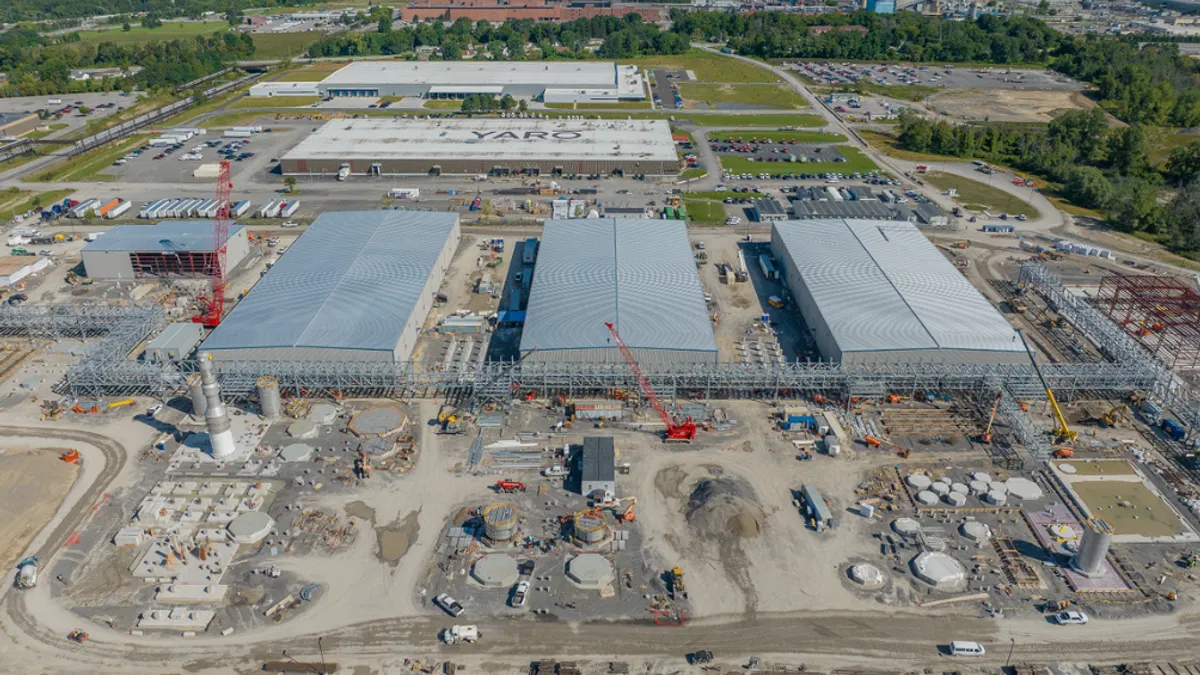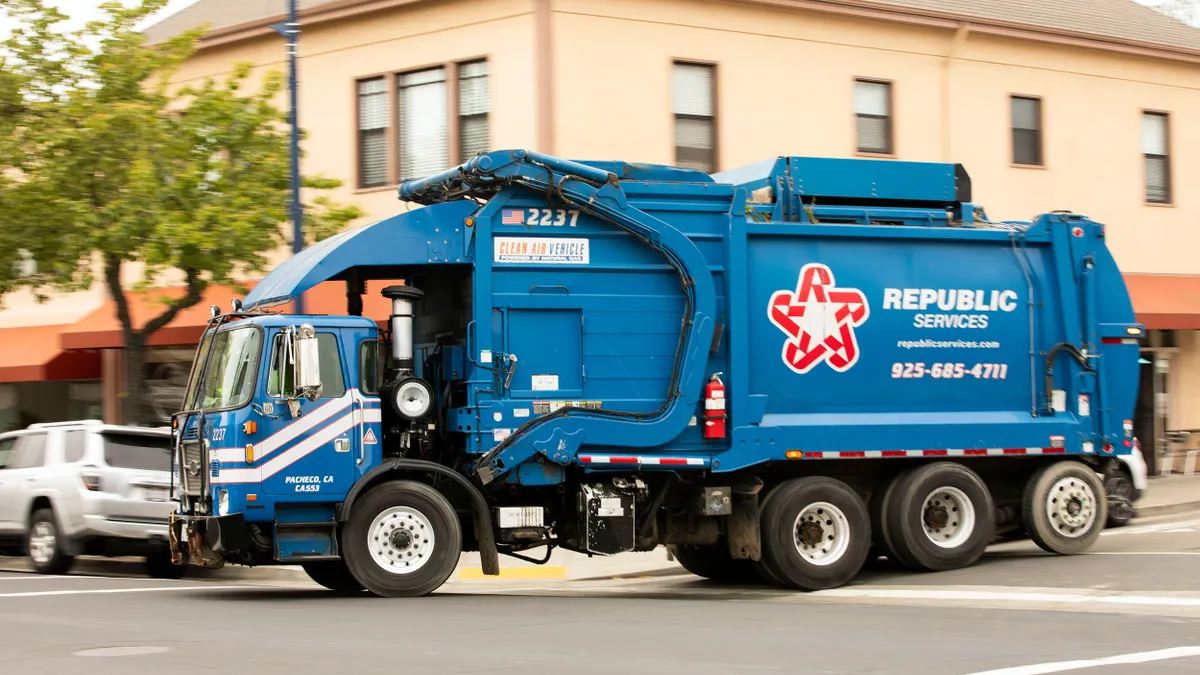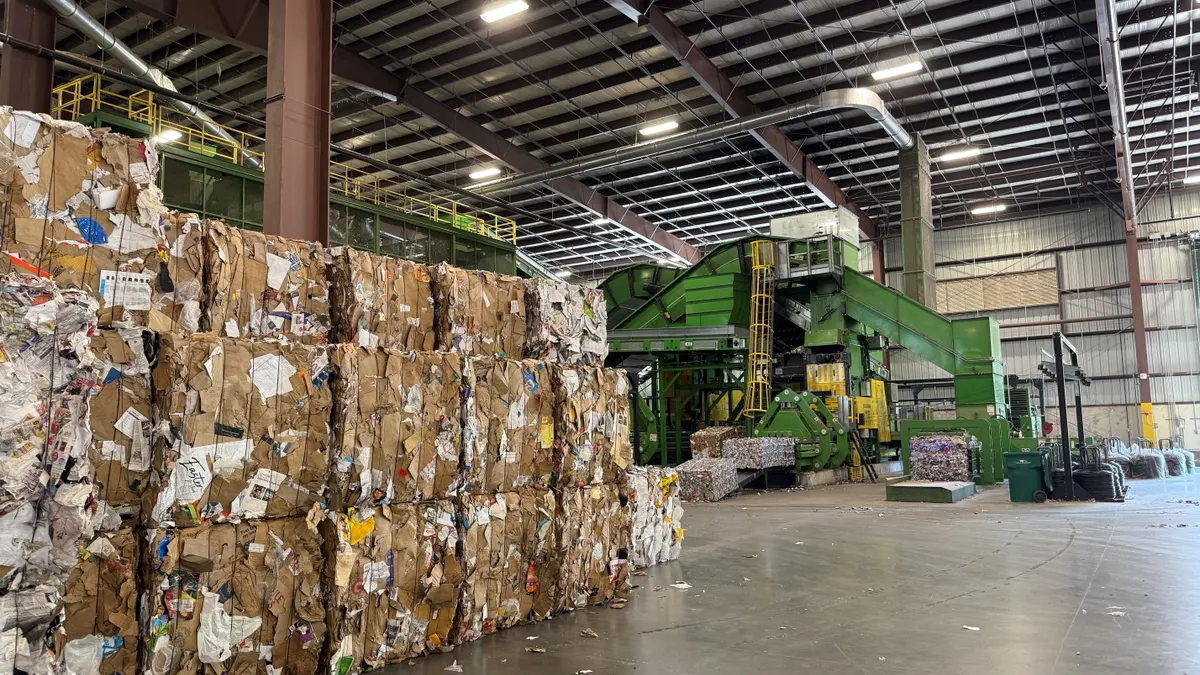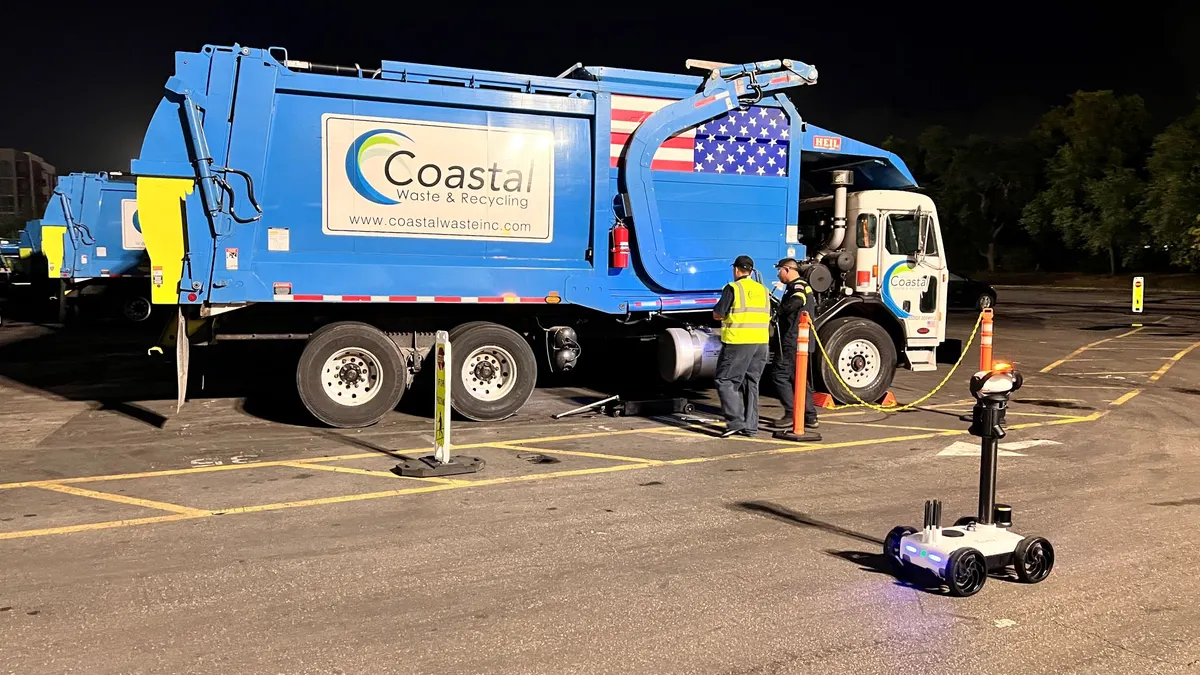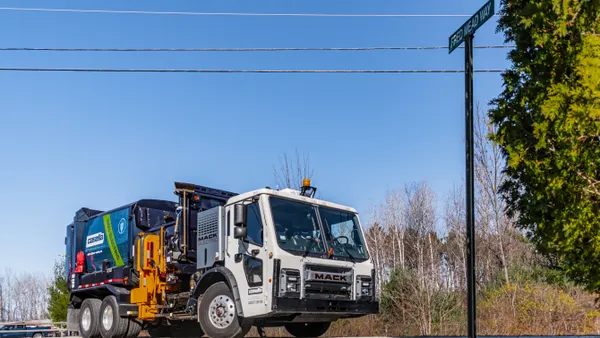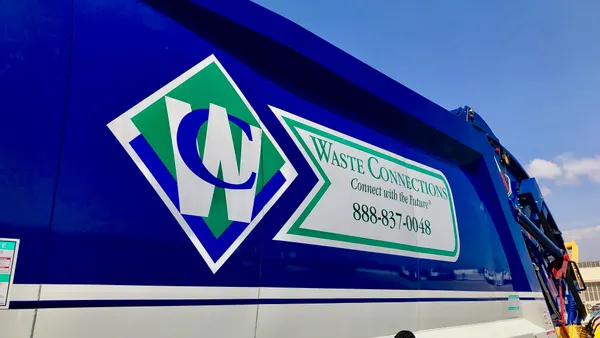This story is part of the Waste Dive Outlook on 2021, a series on the trends that will shape the industry in 2021. For a look at the business trends affecting other industries, see the Dive Outlook on 2021.
In recent years, Waste Dive has shifted away from the annual prediction business. Between China’s scrap import policy changes, surprise M&A moves, effects from the coronavirus pandemic and plenty more, we’ve found this industry is increasingly full of unexpected turns.
Instead, as we map out our beats and strategies for the new year, we’re letting you in on the planning process for covering whatever may lie ahead in 2021. As we ramp up, these are some of the key questions and themes we'll keep coming back to in the months ahead.
The following analysis is based on reporting and research by the Waste Dive team. We invite you to share thoughts on these questions, or others of your own, via email at waste.dive.editors@industrydive.com.
Will climate and circular economy goals reshape the industry’s status quo?
The waste and recycling industry’s largest service providers say they’re agnostic on where material goes once it’s picked up, for the right returns. That concept may be put to the test even more this year due to growing attention around environmental, social and corporate governance (ESG) goals, pressure on consumer brands to improve how their products are made and recycled, the looming climate crisis and promises from government officials at all levels to drive change.
If industry companies want to meet their targets around reducing greenhouse gas emissions and boosting recycling volumes, some analysts and observers believe they will need to make new capital investments and potentially pivot more to certain lines of business. Common areas of interest may include new fleet technology, more advanced emissions management systems at disposal sites, enhanced MRF equipment and greater organics processing capabilities.
While this approach isn’t new for some operators, the pace and scale of change that will be needed to meet the ESG goals of the companies’ investors, customers and regulators could mark a notable inflection point. This fresh attention could also potentially affect competitive dynamics among existing operators, while boosting others in adjacent sectors – such as standalone organics recycling companies – and invite new or enhanced investment from outside players.
How will industry competition and consolidation evolve in an uncertain year?
While many in the industry have recovered much of the business lost from the pandemic’s initial shocks, it remains hard to predict how much the economy will improve this year. With Democrats poised to control the federal government, analysts have also made numerous projections about potential corporate tax changes and other financial shifts that could affect M&A.
This industry is coming off a booming period of M&A activity during the Trump era, fueled in part by corporate tax changes, and 2020 was quite busy despite pandemic-related delays. While some analysts believe Waste Management and Republic Services may have done their last major deals – pending the latter’s acquisition of Santek Waste Services – other companies have multiple options left for big transactions. And the industry still has numerous opportunities for deals ranging from tuck-ins to larger private companies. Sources indicate it’s too soon to know what effect the Biden administration may have on industry antitrust policy, and will depend in part on pending leadership announcements.
Beyond these national trends, local questions of how and where key industry players will compete for business – from jockeying for customer accounts and collection contracts up to the dominance of transfer and disposal assets – will inform both M&A and organic growth. As the aftermath of last year’s deals shakes out, multiple regional markets are adapting to a scenario with fewer competitors or watching as newer ones make their moves. Legislative and regulatory drivers, such as New York City’s commercial waste zone contract process and upcoming organics diversion requirements in multiple states, are also likely to spur more changes.
How will landfills, incinerators and other major industrial facilities adapt to rising operational and financial pressures?
Even if disposal volumes were to shift notably – an outcome few expect – current sites will remain key elements of infrastructure for the foreseeable future. Operating these sites has never been simple. When factoring in increased scrutiny around greenhouse gas and other emissions, leachate management and tense community relations, it’s only going to get more complex and expensive.
Among the most pressing new issues is managing per- and polyfluoroalkyl substances (PFAS) in the waste stream. Some in the industry hope this could be the year it can move from a more defensive posture of sorting out potential infrastructure changes and legal exposure, to a more proactive footing. Depending on how regulations evolve, certain types of wastewater processing or disposal technologies could step up as part of the solution. Following the U.S. EPA’s recent draft disposal guidance, much more action is expected under Biden.
The issue of environmental justice, a decades-old concept getting renewed attention in recent years, is also an underlying factor around many disposal sites. The Biden administration has pledged to make it a focus, multiple state and local governments are passing or considering new laws, and the equity question is not going away.
Is 2021 finally the year for big federal or state recycling policy changes?
Unlike parts of Canada and Europe, the United States has been slow to adopt extended producer responsibility (EPR) programs for packaging. Last year’s efforts were stalled because of the pandemic, but 2021 could be the time for some of these policies to make headway at the state level.
New bills have been previewed or proposed in New York and Washington, with an estimated 10 or more states expected to see EPR legislation this year. That list includes California, which became the first in the nation to enact a recycled content requirement for plastic beverage containers last year. Other states might follow suit on recycled content legislation, including New Jersey.
At the federal level, one EPR-related bill that previously failed to gain traction in Congress but could make a comeback is the Break Free From Plastic Pollution Act. Several environmental groups support it because of features such as packaging EPR, product stewardship regulations and plastic bans or reduction efforts.
The industry is also keeping an eye on the new administration, which has said it will support climate and clean energy initiatives but has yet to announce plans specific to recycling. A group of community and environmental advocacy groups have asked Biden to enact plastic recycling-related initiatives outlined in an action plan, such as creating an office for recycling market development and waste reduction and appointing a plastic pollution czar.
What will it take to make recycled content levels rise and domestic markets grow in a significant way?
Some experts anticipate 2021 could be a period of recovery for domestic recycling markets as municipal recycling systems get back to pre-pandemic operations and MRFs rebuild partnerships with plastics manufacturers and brand owners willing to integrate higher percentages of recycled content into their products. Recyclers are still working on how to invest in and expand domestic markets for items like paper and plastics that used to go to China and other countries that have enacted similar import bans.
In its recent draft national recycling strategy, the EPA includes priorities such as reducing contamination in the recycling stream, improving domestic markets for recyclables and increasing efficiency by connecting industry operators with tools and funding they need. The passage of Save Our Seas 2.0, which President Trump signed in December, offers $55 million in funding each year through 2025 for improving "local post-consumer materials management," that includes municipal recycling.
MRFs are also continuing to seek grant funding for pilot projects that could help strengthen markets for harder-to-recycle materials, such as plastic film, plastic bags or polypropylene. Many are using the funding to upgrade equipment to integrate robotics or other cutting-edge processing technologies to create cleaner streams of recyclables that could be more attractive to domestic buyers, but many of these efforts can take years to fully develop.
North American mills are also in the process of increasing recycled paper capacity to accommodate material that once went overseas. At least 28 expansion or conversion projects have been announced since 2018, or are in the works, with nine completed so far. The Northeast Recycling Council, which tracks these projects, says it’s not guaranteed that all projects will be completed.
Recyclers also say brands and retailers will still play a major role in influencing domestic market growth when they announce sustainability goals and pledge to use recycled content in their products and packaging. Public pressure to increase the recycled content of their packaging will continue to be an important market driver, but some worry these companies’ efforts to replace virgin materials with recycled alternatives may stall if the cost difference, particularly for plastics, remains wide.
How can local governments build back their budgets and preserve their sustainability goals when it comes to waste and recycling services?
Life during COVID-19 has in many cases distanced cities and states from sustainability goals. New York cut residential curbside organics collection, Baltimore delayed implementation of its planned single-use plastic bag ban, Philadelphia eliminated its Zero Waste and Litter Cabinet, Denver’s hopes to adopt a pay-as-you-throw system didn’t feel appropriate while so many people faced economic hardship, and one San Francisco newspaper simply described California’s current recycling system as “a dumpster fire.”
The pandemic upended local budgets, in some cases lowering the priority of waste and recycling programs, as equally constrained customers struggled to pay bills. At the start of the new year, local governments remain stretched thin, particularly in the aftermath of being cut out of funding in the $900 billion coronavirus aid package passed by Congress last month.
Some municipalities have enacted typically unpopular rate increases to keep waste and recycling services going. And some are optimistic about how the Biden administration’s outlined climate actions, including boosting green infrastructure, could help them in recovering from the pandemic. With Democrats set to have control of Capitol Hill, state and local government relief is expected to come up in a future relief bill. At the same time, the onus may also fall on haulers and equipment manufacturers to adapt how they approach pricing and purchasing discussions with cities during the recovery.
Where will we see the next big advancements and investments in collection technology?
While city sanitation or public works departments may be limited on near-term investments, healthier cash flow at private companies could still support fleet upgrades.
In the bid to electrify collection fleets, 2020 ended with a fizzle as Republic Services and Nikola called off plans to design and build at least 2,500 vehicles, in part citing unforeseen costs. Although that deal had marked the largest industry commitment to date, Republic said it plans to keep working with other OEM partners toward electrification, as will its peers. Compressed natural gas vehicles also remain an area of investment, but are now more commonly viewed as an interim option.
Widespread changes to fleets won’t happen overnight, but falling costs of electric vehicles and increasingly attractive total cost of ownership analyses, ambitious city and statewide emissions mandates coming down the pike, and investor interest in ESG targets are among the factors that could push electrification efforts forward this year. Broadly, Biden has voiced support for expanding EV charging infrastructure, a current barrier.
Elsewhere, cameras and other technologies still have runway for adoption – particularly as safety incidents continue to vex the industry despite years of effort – as do products used to make routes more efficient, right-size containers and pickups, and allow waste management companies to more proactively communicate with customers. Investments in these areas could provide competitive edges for companies of all sizes, making technology an increasingly important area to watch.
Amid an ongoing pandemic, and a challenging national record, how safe will it be to work in this industry?
The pandemic has served as a reminder of how “essential” the waste and recycling industry is, according to state and federal designations, while also highlighting the physical vulnerabilities of its workforce. Thousands of workers are estimated to have contracted the coronavirus on and off the clock, and it’s estimated that dozens have died. As the vaccine rollout starts at a slow pace, the numerous workers who still have limited options for social distancing on the job could remain at risk.
At the same time, the industry’s long-running challenge of improving broader safety metrics remains a work in progress. While federal data indicated collection workers were no longer in the top five most fatal occupations for 2019, many agree it’s too soon for a victory lap. A recent federal study also found public awareness of the industry-supported “Move Over” laws remains low, signaling the continued need for creativity in this area. Figuring out how to protect workers from physical or viral hazards is likely to remain an ongoing challenge, and is a question that may bear repeating for years to come.
Will commitments made by many industry companies and groups after last year’s racial reckoning remain a priority?
Diversity issues weren’t new to the industry before last year’s racial reckoning, but they took on greater prominence and prompted fresh discussions. Conversations about improving representation and equity permeated everywhere from local advocacy groups to major public companies. The conversation also lifted up issues such as hazard pay for a frontline workforce that largely comprises people of color in many areas, as well as environmental justice considerations.
Many of these discussions have fallen out of the spotlight, and observers believe it remains an open question if or how the industry will evolve on this topic. Leadership and managements roles in many parts of the industry are still less diverse than many sectors, per federal data, and debate continues about wage or working conditions for frontline employees in multiple areas. Waste Dive will continue following up on progress – or lack thereof – throughout the year.







